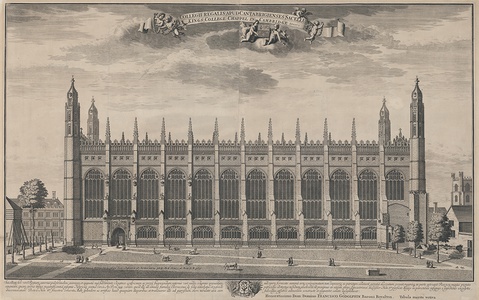| Method | Copper engraving |
| Artist | Johannes Kip after David Loggan |
| Published | London, c. 1720 |
| Dimensions | Image 562 x 885 mm, Plate 560 x 890 mm, Sheet 595 x 950 mm |
| Notes |
A wonderful uncommon print of King's College Chapel from the the south printed for Kip's Britannia Illustrata. This print is an enlarged version of David Loggan's earlier 1690 view from his Cantabrigia illustrata. Johannes 'Jan' Kip (1653 - 1722) was a Dutch draughtsman, engraver, and print dealer who was active in England, after producing works for the court of William of Orange in Amsterdam. Following the Glorious Revolution of 1688, Kip accompanied the Court to England and settled in Westminster, where he conducted a thriving print selling business from his house in St. John's Street. He also worked for various London publishers producing engravings, largely for book illustrations. His most important works were the execution of the illustrations for Britannia Illustrata, 1708, The Ancient and Present State of Gloucestershire, 1712, and Le Nouveau Theatre de la Grande Bretagne, 1715. His attractive and informative bird's-eye views of English country seats for the Britannia Illustrata were originally created in collaboration with fellow Dutch artist, Leonard Knyff, with Knyff creating the drawings, and Kip the etchings. As the project developed, however, Kip created his own drawings and etchings. David Loggan (1635-1692), artist and engraver, was born at Danzig in 1635. He may have learnt the art of engraving from Simon van den Passe in Denmark and from Hendrik Hondius in the Netherlands. Loggan followed Hondius's sons to England in about 1653, and by 1665 he was residing at Nuffield, near Oxford, and had made the acquaintance of the antiquarian Anthony Wood. On 30 March 1669 he was appointed Engraver to the University of Oxford, with an annual salary of twenty shillings. He married a daughter of Robert Jordan, Esq. of Kencote Hall in Oxfordshire in 1671, and in 1672 they had a son, John Loggan, who later graduated from Trinity College. The marriage probably produced another son, William Loggan, about whom little is known except that he was responsible for a satirical print of Father Peters and the Jesuits, published in 1681. David Loggan took up residence in Holywell in about 1671, prior to matriculating at the University. In 1675 he was naturalised as an Englishman. The remainder of his life was spent mostly in London, where he worked as an agent and art dealer, and as Engraver to the University of Cambridge, a position he attained in 1690, two years before his death. Loggan's two great works were a series of architectural bird's eye plans of the colleges and public buildings of Oxford and Cambridge, the Oxonia Illustrata, published in 1675, and its rarer sister Cantabrigia Illustrata, which appeared at some point previous to 1690. Following Loggan's death, the plates were acquired and reprinted by Henry Overton in 1705 and c.1710 respectively. Cantabrigia Illustrata, like its earlier Oxonian counterpart, was the first illustrated book on Cambridge and one of the major works of the 17th century. Begun shortly after the publication of Oxonia Illustrata in 1675, the work was likely inspired by the time Loggan spent at Trinity College working on prints of Wren's designs for Trinity College library. Although the exact date of publication is unknown, it was certainly in circulation by 1690, the year in which Loggan was appointed Engraver to the University of Cambridge. Condition:Pressed vertical and horizontal creases as issued, several repaired tears on old creases, and remains of old brown paper framing tap on edges of margins. |
| Framing | unmounted |
| Price | £1,800.00 |
| Stock ID | 53412 |

